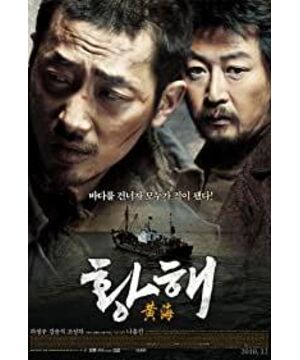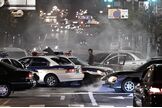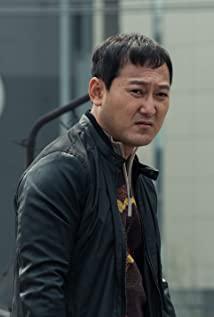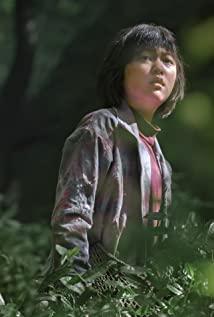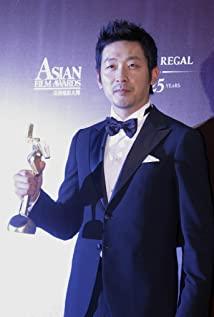The audio-visual content I analyzed is the action sequence, and the selected segment is the chase sequence in "The Yellow Sea" directed by Luo Hongzhen of South Korea, which is located at 1:43:11-1:46:50 of the film (the full-length 156-minute theatrical version). This part is mainly about chasing, and combines the audio-visual paragraphs of fighting. It uses techniques such as hand-held, fast editing, telephoto panning, and synchronized camera movement. At the same time, the two protagonists are interspersed with looking shots, realizing the rhythm of relaxation and relaxation. , completes the entire chase paragraph in high quality. The following mainly analyzes how the director realizes the sense of rhythm in the action paragraphs:
1. Divide the "beat" by the purpose of the characters' actions
This passage is about Jiunan (played by Ha Jung-woo) who was deceived at the port and encountered Mr. Mian (played by Kim Yoon-suk) who wanted to kill him and his subordinates. According to the overall goal to be accomplished by the protagonist, it is subdivided into five tasks: one is to push open the container door blocked by the crooks, the other is to be chased by the crooks pushing the box, the third is to be chased by Mr. Mian and his subordinates, and the fourth is to escape on the side of the boat While playing, the fifth is deck jumping into the sea. Among them, between the second and third and the fourth and fifth, the face-to-face with Mr. Mian was arranged, which became the slow-paced part. As a result, 5 fast beats and 2 slow beats form an action paragraph of 7 beats.
Defining the task and dividing the rhythm can make the action motivation of the entire paragraph clear and changeable, and the characters constantly have new goals and challenges, which can better attract the audience's attention. At the same time, through the escalation of the difficulty of the task, the escalation of the level of catalyzed violence makes the characters forced to grow up. It can be seen that in the process of survival, as the confrontation force becomes stronger, Jiu Nan has to put in more effort. Jiu Nan's worries are getting more and more, and the "cool feeling" that Jiu Nan brings to the audience will gradually strengthen when he overcomes difficulties.
2. Audiovisual design in the tense chase part
In the process of pushing the door, the tight composition of close-up and close-up shots brought a sense of urgency and tension. The director designed the villain to hold a flashlight in his hand. The shaking of the light of the flashlight and the shaking of the camera jointly rendered the uneasy characters of the characters. mental state. At the same time, the fast editing using the hand-held shaking lens is not suitable for giving too much information in a single shot. This action of pushing the door uses 42 shots in 30 seconds, because the single shot stays for a short time, and there is too much information in the picture. It is quickly captured, such as the shot of pulling out a dagger, so the information in a single shot is very clear and intuitive. In the part of pushing the door, the director also designed several bridges, from opening the door and closing the door, to Jiu Nan putting a hand out of the door, and then asking Jiu Nan to take out a dagger, extending the dagger from the crack of the door and piercing the outside The result is awkward, and the action design not only improves the sense of realism, but also increases the fun.
In the process of chasing, shooting Jiunan and the person chasing him separately, the escaper and the chaser are in different frames, but run through the same place respectively, as if they are about to catch up; when the frame is the same, use the telephoto The shot, which compresses the distance between the runner and the chaser, also makes it feel like they are about to be caught up. When shooting from the side, using the telephoto remote shooting can make the background flash quickly and enhance the sense of speed; the front and back lenses use the wide-angle lens to move synchronously. , the buildings on both sides of the building are obviously retreating, which can make the characters run very fast. In the process of escaping, Jiunan turned back and turned, which made the characters change direction continuously, which made the running process more beautiful. Constantly setting obstacles for Jiu Nan can also enrich the process of escape. For example, the director designed a locked door, and Jiu Nan could not open it at first, but the audience worried that he would be caught, and then let the enemy enter the camera , after a fight, and then let Jiu Nan escape, the audience will experience the thrill of being in danger.
In the process of fighting, use off-axis, non-action continuous clips, and insert effect shots of phantom shadows to enhance the sense of chaos. I speculate that the shooting process is, in each camera, mainly close-ups, take a long fight scene, and then keep the best shot that can reflect the effect, and edit the shots from different positions together. The purpose of editing is for the overall effect of the fight. The action design of the fight is novel and unique, which can enhance the viewing interest. For example, when Jiunan escaped from the boat and wanted to close the door, many of the chasers inside stretched out their handles from the cracks of the door. The outstretched hand, which is weak and has the upper hand, is very interesting; another example, after Jiunan jumped into the sea, Mr. Mian threw an axe before he could catch it. The cold weapon of close-range attack was transformed into a long-range throw. Weapons are fun.
In addition, I found that there is no close-up of running feet in this chase scene, and there is no wide-angle overhead shooting environment. It may be to unify the documentary style, and to avoid the sense of detachment brought by expressive shots, so as not to let the audience relive it. I have been stimulated by the actions of the protagonist, and before I can recall, new actions will take place to maintain the tension and excitement.
There is also something in this clip that I think is unreasonable: when Jiu Nan was forced to a corner of the boat, Mr. Mian could have his subordinates surround him together, and Jiu Nan would not have time to overturn the railings, but he chose himself Go in person and order his subordinates to get out of the way, causing Jiunan to escape. This may be to form a confrontation again, and to design breathing in the action to insert the slow-paced part, but Mr. Mian's self-confidence is a bit deliberate, and the villain's settings are too stupid and a bit low-level. The solution I gave was: arrange for Jiunan to pretend to negotiate, and Mr. Mian disagreed with swearing, but Jiunan already had an opportunity to escape, which was more comfortable than Mr. Mian taking the initiative to be stupid.
3. Audio-visual control in the breathing space part
After an action scene, Luo Hongzhen will arrange for the characters to reflect on the scene. Through the level-breaking plot, the characters will obtain new information after completing the staged success, and then film the state after he has obtained the information, giving the actors enough space to perform. . Lengthening the moment reflected by the character can increase the effect of the character's emotions, form a gap in the action, and combine the action with the plot. For example, when Jiu Nan fled to the gate of the wharf and saw Mr. Mian, it was the first time he saw the person who framed him after he discovered the conspiracy. His psychological state was doubt, resentment, fear, and disbelief. The camera first shot Jiu Nan's subjective lens. The panorama, Jiunan reflected, and then cut to the close-up of the subjective lens to see Mr. Mian clearly, then to Jiunan to reflect, Mr. Mian to reflect, multiple groups of front and back fights, Jiunan's "seeing" included both facing Mr. Mian and chasing soldiers from behind. Therefore, he has the state of looking back many times, the process of hesitation and thinking, repeated many times with frontal close-up and side close-up, and when Jiunan was still being chased, he gave him a long psychological description, which lasted for a long time. 34 seconds.
When there is a narrative appeal in the action, and the director wants the audience to see the content clearly, he will also slow down the speed for a moment. For example, in the chase on the boat, Jiu Nan killed the first time in this paragraph, and the violence has escalated since then. Gore footage begins to appear. Therefore, after the man was knocked down, the scene of bleeding on the head and the reflection scene of Jiu Nan stayed for a long time, which strengthened that Jiu Nan had already started a life-and-death struggle to escape for his life. The audience should have enough time to receive this. information, and start a new chase.
Fourth, the director's overall concept summary
When the director conceived of the chase scene, in order to avoid the tediousness of running in a straight line, he designed several obstacles and escalation of contradictions, so that the escapee could turn and overcome difficulties many times in the process, which could enrich the content of the escape action. . Between several tense chases, join the confrontation and reflection of the characters, let the rhythm slow down and stretch for a long time, forming an opportunity for respite. Controlling the intensity of the tension and the length of the breath is the key to the design of this part of the chase paragraph.
Extending the time in the reflection shot is the same as shortening the time in the chasing shot, both to achieve a psychological effect, let the audience run nervously, and then stop to breathe. Interspersed, it will form a patchwork of action paragraphs.
It is not enough for a good chase sequence to be interspersed with fast and slow, and the fast and slow parts should also be exciting enough when taken out alone. The action of chasing and fighting should be designed with novel actions, such as stabbing a knife in the door, knocking away the chaser, and throwing an axe to increase the viewing experience. The scenes of confrontation and reflection must have actual plot advancement, not empty pretentiousness. Breathing without narrative will have a sense of stagnation. Only when the narrative is integrated, the non-action part will have meaning, and the part that connects the action will have a sense of smoothness. In a word, the sense of rhythm of action paragraphs is a comprehensive feeling. The design of fast and slow is reasonable and the matching is appropriate, which can create better effects.
View more about The Yellow Sea reviews


